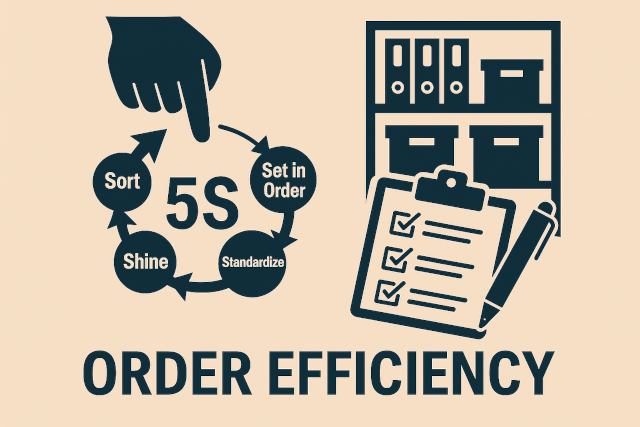In the fast-paced world of warehousing, manufacturing, and distribution, one of the biggest threats to productivity isn’t lack of effort—it’s disorganization. Think about how much time is lost daily searching for misplaced tools, navigating cluttered workspaces, or dealing with inconsistent procedures. These seemingly small inefficiencies snowball into lost hours, reduced morale, and higher operational costs. That’s where 5S comes in.
Originally developed in Japan as a core element of the Toyota Production System, 5S is a foundational Lean methodology aimed at organizing and maintaining an efficient, safe, and high-performing workspace. While its origins are in manufacturing, 5S has proven powerful in distribution centers, warehouses, office environments, and beyond.
Let’s explore what 5S is, why it works, and how you can begin applying it in your operation.
The 5 Pillars of 5S
At its core, 5S consists of five steps, each building on the previous to establish a clean, organized, and standardized environment:
1. Sort (Seiri)
This step is about eliminating the unnecessary. Every workspace collects clutter over time—obsolete tools, extra equipment, old stock, outdated labels, unused materials. These items take up space, create confusion, and slow down your team.
- Key Actions:Red-tag items not needed for daily work.
- Review tools, parts, and paperwork with staff to determine what stays and what goes.
- Move unnecessary items to a “quarantine” area for further review or disposal.
Goal: Keep only what you need. Clear out the rest.
2. Set in Order (Seiton)
Once you’ve cleared the clutter, the next step is to assign a logical place for everything. This isn’t just about storage—it’s about efficiency and flow. Can your team find what they need without searching? Can they return items without confusion?
- Key ActioUse visual tools like floor tape, labels, and shadow boards.
- Group tools and supplies by frequency of use.
- Designate homes for mobile items like ladders, carts, and PPE.ns:
Goal: A place for everything, and everything in its place—every time.
3. Shine (Seiso)
This step goes beyond basic cleaning. It’s about inspecting and maintaining the condition of your workspace and equipment daily. Clean areas are safer, easier to work in, and more likely to reveal problems early.
Key Actions:
- Assign daily cleaning tasks by area or role.
- Inspect equipment for leaks, damage, or wear while cleaning.
- Encourage pride in a clean workspace.
Goal: Spot problems before they grow. Create a safe and inviting environment.
4. Standardize (Seiketsu)
Now that you’ve sorted, set in order, and cleaned—how do you ensure consistency? Standardization keeps everything in place and helps new team members get up to speed quickly.
Key Actions:
- Create visual SOPs (standard operating procedures).
- Use photos and diagrams to show how each area should look.
- Schedule regular checks and assign accountability.
Goal: Make best practices the normal way of working—not just a one-off cleanup effort.
5. Sustain (Shitsuke)
The hardest part of 5S isn’t starting—it’s maintaining. Sustain is about building discipline, habits, and culture so that 5S becomes second nature to everyone on the team.
Key Actions:
- Incorporate 5S into training and onboarding.
- Perform regular audits with positive feedback.
- Celebrate progress and improvement over perfection.
Goal: Build a culture where 5S is owned by everyone, every day.
Why 5S Works
5S is deceptively simple, but its impact can be profound. Here’s why it works so well:
- Reduces waste: Less time spent looking for tools or materials = more time working.
- Improves safety: Clean, well-marked areas reduce trips, spills, and accidents.
- Boosts morale: A tidy, organized space shows respect for people and pride in the job.
- Supports continuous improvement: Standardizing work provides a stable base to identify and solve deeper process problems.
Real-World Applications in Warehousing and Distribution
Imagine walking into a warehouse where:
- Every tool has a shadow board, and nothing is ever missing.
- Picking carts and forklifts are parked in marked zones.
- Inventory is clearly labeled and easy to access.
- Aisles are clean and uncluttered.
- Employees conduct a 10-minute “clean and check” at shift end.
That’s the power of 5S in action. It’s not flashy—but it builds the kind of discipline and flow that make high-volume operations thrive.
Getting Started with 5S
Starting 5S doesn’t require fancy software or expensive consultants. Here’s a simple roadmap:
- Pick a pilot area. Start small—one workbench, one shipping station, one aisle.
- Hold a kickoff. Educate the team on 5S and why it matters. Get their input.
- Run a 5S blitz. Spend a day or week fully implementing all 5 steps.
- Create standards. Take pictures, write checklists, and assign responsibilities.
- Audit and adjust. Set regular review intervals and use them as learning tools.
Final Thoughts
5S is more than just cleaning—it’s about clarity, flow, and respect for the work. When done well, it becomes the foundation for deeper Lean practices like visual management, Just-In-Time, and Kaizen.
Whether you manage a warehouse, production floor, or even an office, 5S creates the structure and focus needed to reduce waste and unlock your team’s full potential.
Start with 5S. Stick with it. And you’ll never look at a cluttered workspace the same way again.



